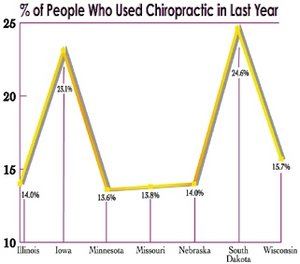Of course when it comes to chiropractic utilization, we all suspect that there are broad differences state to state. That assumption has been confirmed by the recent publication of a rural health research project conducted by two researchers from the Palmer Center for Chiropractic Research.1
The study looked at the factors affecting use of chiropractic services in seven Midwest states: Illinois; Iowa; Minnesota; Missouri; Nebraska; South Dakota, and Wisconsin. The study examined such factors as race, religion, age, education and size of community the patients lived in.
The study took data from the 1994 Heartland Poll, a random telephone survey conducted by the University of Iowa Social Science Institute. Using a sample size of 1,511, the authors found these percentages of the population that said they had visited a doctor of chiropractic in the past year (see graph below).
These usage figures are of particular interest in regard to the location of chiropractic colleges in the Midwest. South Dakota, which had the highest percentage of chiropractic patients, doesn't have a chiropractic college; Minnesota (with the lowest percentage) does. And while Iowa, with the second highest percentage of patients, has Palmer Chiropractic College, Missouri, with two chiropractic colleges, has the second lowest percentage of patients. "Curiouser and curiouser," to quote Lewis Carroll.
In examining the demographic characteristics of chiropractic users and nonusers, the authors found that gender, age, health care coverage and employment status were "not significantly related to chiropractic use." It was interesting, however, to note the age range of the chiropractic patients:
Age(Years) Users %
18 to 34 31.8
35 to 54 45.1
55 and older 25.2
The authors noted that: "Although education and income were significantly related to chiropractic use univariately, they were not significant at the 0.05 level when considering the multiple regression mode." That said, the education numbers for chiropractic patients were:
Education Users %
Less than high school 6.7
High school degree 66.2
College degree 19.8
Postgraduate or professional 7.3
What the authors did find significant were religious preference, ethnicity and the size of the community:
Size of Community: The study found that people in rural communities were more likely to visit a chiropractor. People in small towns, suburbs and cities were only half as likely to be chiropractic patients as those in rural areas.
Race: American Indians were more than three times as likely to be chiropractic patients as Caucasians. On the other hand, Caucasians were:
• 20 times more likely to visit a DC than African-Americans;
• 14 times more likely to visit a DC than Asians;
• 12 times more likely to visit a DC than Hispanics.
Religion: In Iowa and South Dakota (the two states with the largest percentages of chiropractic patients), Catholics were 50% more likely to be chiropractic patients. In the other five states, Protestants were two-and-a-half times more likely to be chiropractic patients.
While we should not generalize this study to the chiropractic utilization rates for the rest of the U.S., it does paint a fairly clear picture. Doctors of chiropractic must make a greater effort to reach out to Hispanics, Asians and African-Americans in small towns, suburbs and larger cities. The challenges inherent in marketing to more highly populated areas require cooperation among DCs. This may explain why those chiropractors in rural communities appear to be more successful.
The interesting differences between the five states with less than 16% chiropractic patients and the two states (South Dakota and Iowa) with more than 23% should also be noted. While there could be another explanation, the 7% difference appears to reflect penetration into the Catholic community. Suffice it to say, if all states could make this 7% jump, the profession would enjoy over 14 million more chiropractic patients, or 230 new patients for every chiropractic practice.
Reference
Hawk C, Long CR. Factors affecting use of chiropractic services in seven midwestern states of the United States. J Rural Health 1999:15;233-239.
Dynamic Chiropractic editorial staff members research, investigate and write articles for the publication on an ongoing basis. To contact the Editorial Department or submit an article of your own for consideration, email
.





